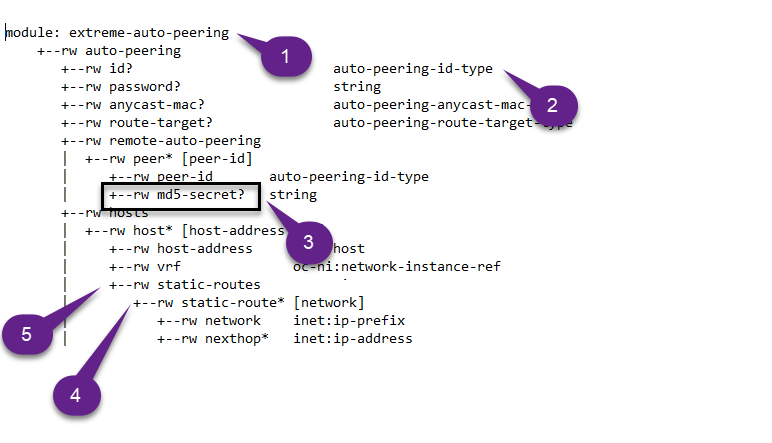YANG Data Models
YANG is a data modeling language used to model configuration and state data as published in RFC 6020. The ExtremeXOS RESTCONF interface supports YANG models defined by standards bodies and community groups such as IETF and OpenConfig, as well as native YANG models. Some aspects of the data model to note:
- Every data model is a module, a self-contained top-level hierarchy of nodes.
- The data model uses containers to group related nodes.
- The data model uses lists to identify nodes that are stored in sequence.
- Each individual attribute of a node is represented by a leaf.
- Every leaf must have an associated data type.
YANG Data Model Components

| Callout | Description |
|---|---|
| 1 | Module name |
| 2 | Data type |
| 3 | Leaf |
| 4 | List |
| 5 | Container |

Note
To see the published YANG model tree, URLs for each supported YANG model, and the complete JSON for the YANG model, go to ExtremeXOS RESTCONF API Reference.
| Data model | Description |
|---|---|
| openconfig-bgp | Defines a limited subset of the BGP protocol configuration data. |
| openconfig-module-catalog | Provides a schema for cataloging and describing YANG models published across
various organizations. The catalog contains several categories of data:
|
| openconfig-interfaces | Defines data for managing network interfaces and subinterfaces. The following
modules are supported:
|
| openconfig-lacp | Defines configuration and operational state data for the Link Aggregation Control Protocol (LACP). |
| openconfig-lldp | Defines configuration and operational state data for the Link Layer Discovery Protocol (LLDP). |
| openconfig-network-instance | Provides an OpenConfig description of a network instance. This can be a Layer 3
forwarding construct such as virtual routing and forwarding (VRF) instance, or a Layer
2 instance such as a virtual switch instance (VSI). The following modules are
supported:
|
| openconfig-platform | Defines a data model for representing a system component inventory, which can include hardware or software elements arranged in an arbitrary structure. The primary relationship supported by the model is containment (for example, components containing subcomponents). The properties for each component can include dynamic values. For example, a CPU component may report its utilization, temperature, or other physical properties. |
| openconfig-relay-agent | Describes configuration and operational state data related to relay agents typically used for DHCP and BOOTP packets. It supports both DHCP and DHCPv6, and device-wide and per-interface settings. |
| openconfig-telemetry | Creates the configuration for the telemetry systems and functions on the device, to monitor data continuously with efficient, incremental updates. |
| openconfig-spanning-tree | Defines configuration and operational state data for the Spanning Tree Protocol. |
| openconfig-system | Defines data for managing system-wide services and functions on network devices.
The following modules are supported:
|
| openconfig-vlan | Defines configuration and state variables for VLANs, in addition to VLAN parameters associated with interfaces. |
| Data model | Description |
|---|---|
| ietf-access-control-list | Defines configuration and operational state data for the Access Control Lists (ACLs). |
| ietf-interfaces | Contains a collection of YANG definitions for managing network interfaces. |
| ietf-yang-library | Contains monitoring information about the YANG modules and submodules that are used within a YANG-based server. |
| Data model | Description |
|---|---|
| extreme-auto-peering | Defines the auto peering mechanism for cooperating interconnected devices to form a network of any scale for any topology, providing fully redundant, multipath routing. |
| extreme_edge_automation | Defines model for managing Extreme Edge Automation. |
| extreme-fabric | Provides the top-level model for the configuration and operational state of Extreme fabrics. |
| extreme-virtual-service | Defines data for managing Extreme virtual services. |
| extreme-acl-usage | Defines Access Control List rules and usage. |
| extreme-policy-cos | Describes Policy Class of Service feature. |
| extreme-dns-cache | Describes the configuration and operational state data for DNS Cache and DNS Cache Analytics feature provided by Extreme Networks. DNS Cache is a mechanism of caching DNS queries and responses routed through the switch. By default, DNS queries are resolved by forwarding the query to the configured DNS servers and a response is received. Based on the response, the DNS cache is built. For further queries, the DNS cache is referred to resolve instead of forwarding to the DNS server. DNS Cache Analytics analyzes the DNS query logs (both IPv4 and IPv6). Analyzed data maintains a list of DNS queries from connected clients, domain names accessed by clients, and the time stamps of each DNS query. |
| extreme-license | Defines data model for the unified license feature provided by Extreme Networks. |

